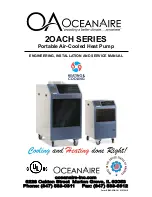
15
SECTION 5.4 – RE-ASSEMBLY
12. Install the piston (16) into the chamber and secure
with the retaining bolt (18) and bolt seal (17). Torque
the piston bolt to 40-50 ft-lbs. Make sure that the
shaft does not twist when the pistons are assembled
and tightened to the shaft. THE BELLOWS MUST
NOT TWIST. Have an assistant place a wrench on the
opposite shaft to hold the shaft still while the retain-
ing bolt (18) is tightened.
FLUID SECTION
If Fluid Sections were disassembled, re-assemble
as follows:
13. Replace the PTFE o-rings (23) in the output blocks
(20), ball cages (26), and flange adapters (27). Insert
balls (25) and seats (24) into the ball cages as shown.
Refer to page 17 for correct ball/seat orientation.
14. The flange adapters (27) to be used on the outlet side
of the pump require a plug (30) and gasket (29). If the
plug (30) has been leaking, replace the gasket (29)
and retighten the plug (30).
15. On the inlet and outlet side of the block, assemble
flange adapter (27) to ball cage (26) containing the
ball (25) and seat (24) – note seat orientation – and
install loosely onto pump with socket head cap
screws (28). Be sure that all Teflon o-rings (23) have
been put into place.
16. Insert screws (28) and secure the items to the block.
Do not fully tighten yet. The flange adapter should be
able to slide back and forth slightly.
Replace fluid section as a unit:
17. Replace the dynamic tube seals (29) on the inlet
flange adapter (27). Slide a dynamic tube nut (31)
onto the dynamic tube (32) that is mounted on the
dynamic chamber (13). The fluid section can now be
attached to the pump as a unit.
18. Seat the piston seal (19) into the output block (20)
making sure that the lip is directed into the block.
NOTE
Bellows must not twist during assembly.
INSTALL FIRST PISTON
INSTALL SECOND PISTON
Place wrench at flats on shaft and hold
while other side is tightened.
Place wrench on piston bolt hex and
hold while other side is tightened.
PTFE
















































